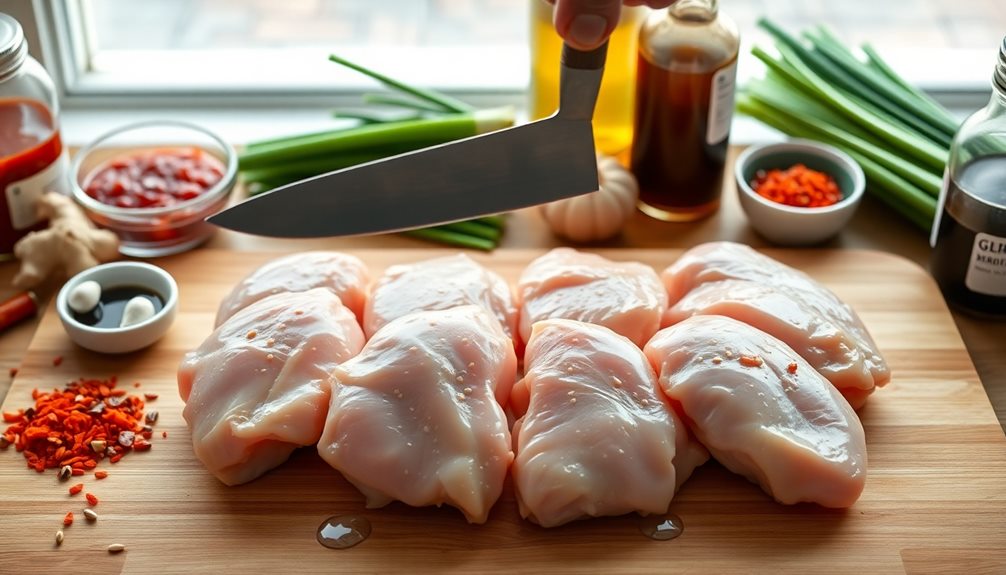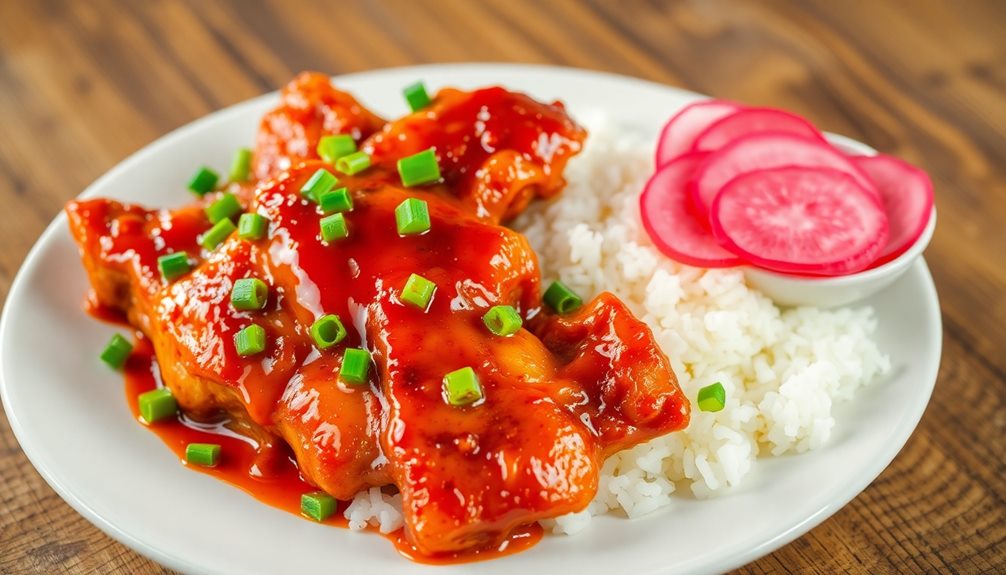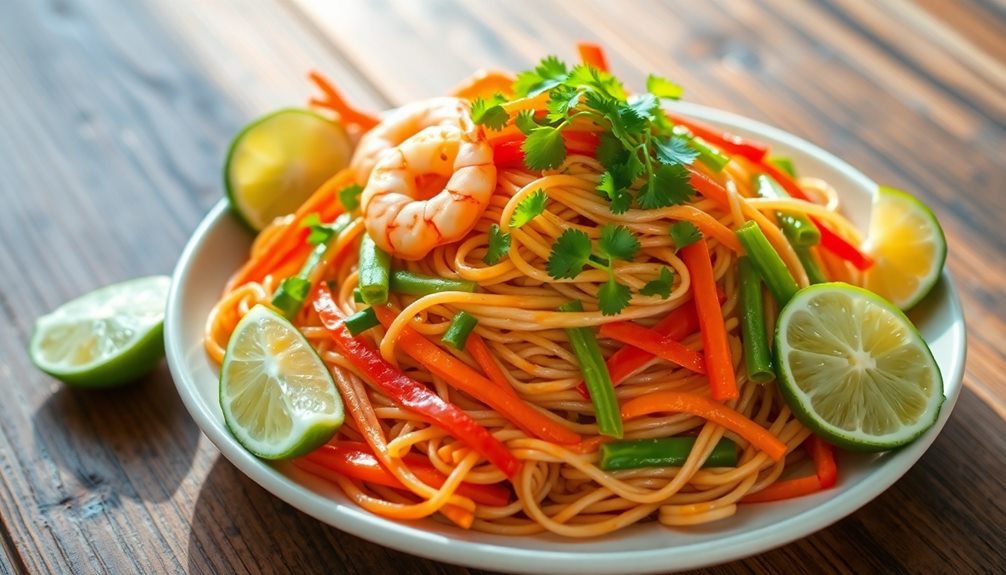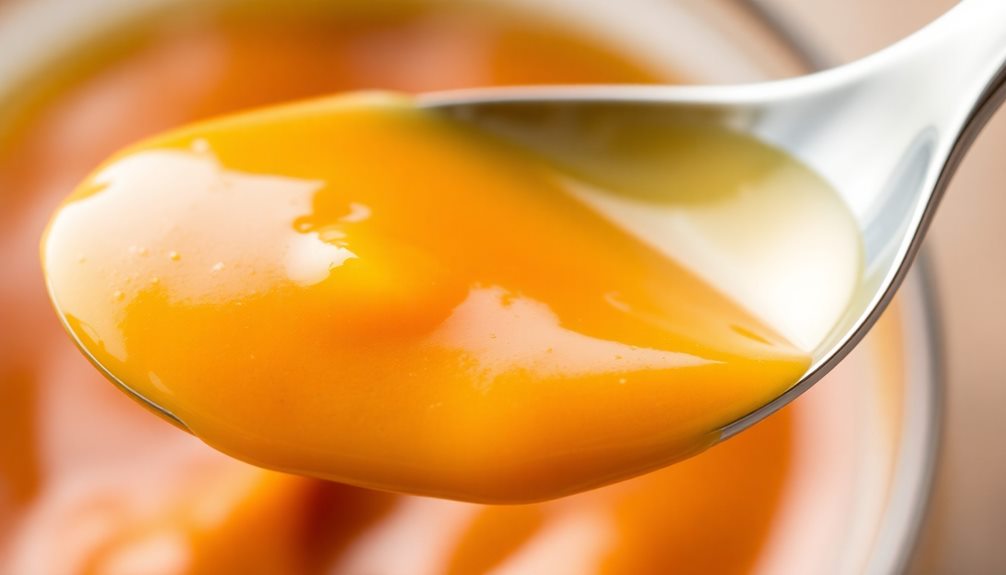Buldak, or "fire chicken," is an incredibly spicy dish that delights heat lovers! Its Scoville level can vary, but it often ranges from 1,500 to over 20,000, depending on how much chili is used. That's hot enough to make your taste buds dance! When you bite into this dish, you get marinated chicken mixed with a fiery chili sauce, often topped with melted cheese for a creamy twist. To cool things down, it's served with refreshing pickled radish. If you're curious about more ways to spice up your meals, there's plenty more to explore!
Key Takeaways
- Buldak, meaning "fire chicken," is known for its high spice level, appealing to heat enthusiasts around the world.
- The spiciness primarily comes from gochugaru, a Korean chili powder, and the quantity used in the marinade.
- Buldak can range from mild to extremely spicy, with some variations exceeding 10,000 Scoville Heat Units (SHU).
- The dish's Scoville rating can vary widely depending on the recipe and personal adjustments to spice levels.
- Enjoying Buldak is often complemented by pickled radish, which balances its intense heat with a refreshing flavor.
History
Have you ever wondered how Buldak, the fiery Korean dish, gained its notorious reputation for heat? It all started in South Korea, where spicy food is a big part of the culture. Buldak, which means "fire chicken," became popular in the early 2000s. People loved the bold flavors and the thrill that came with eating something so spicy!
This dish is made with chicken marinated in a spicy chili sauce, which usually includes gochugaru, a hot Korean pepper. As the years went by, Buldak gained fans not just in Korea but around the world. Street vendors and restaurants began serving it up in different ways, making it even more exciting for everyone.
You might be surprised to learn that Buldak's heat level varies, depending on how much chili is used. Some versions are mild, while others can make your mouth feel like it's on fire!
This fiery dish has sparked a trend of spicy food challenges, where brave eaters test their limits. So, next time you take a bite of Buldak, remember the tasty history that brought this spicy sensation to your plate!
Cooking Steps
To create the perfect Buldak dish, you'll want to gather all your ingredients before diving into the cooking process. First, chop your chicken into bite-sized pieces. This makes it easier to cook and eat later.
Next, grab a big bowl and mix your chicken with the spicy sauce. You can adjust the sauce to make it as fiery as you like! Let it marinate for about 30 minutes so the flavors really soak in.
While your chicken is marinating, prepare the veggies. Slice some green onions and chop up a few mushrooms. These'll add a nice crunch and flavor to your dish.
Now, heat a pan on medium-high heat and add a splash of oil. Once the oil's hot, throw in your marinated chicken. Cook it for about 10 to 15 minutes, stirring occasionally. You'll know it's done when the chicken is fully cooked and the sauce is bubbling.
Step 1. Prepare the Chicken Pieces

Before diving into the cooking process, it's essential to prepare the chicken pieces properly. First, grab some fresh chicken thighs or breasts, whichever you prefer. Make sure they're boneless for easier cooking. Rinse the chicken under cold water, then pat them dry with paper towels. This helps remove extra moisture, making the cooking process smoother.
Next, cut the chicken into bite-sized pieces. You want them small enough to cook quickly, but not too tiny that they lose their juicy goodness. Think about making them about one inch in size. This way, they'll soak up all the delicious flavors later on!
Once you've chopped the chicken, it's time to check for any leftover bits of fat or bone. You don't want those sneaky surprises while you're enjoying your meal!
After everything looks good, place the chicken pieces in a bowl. This will be their home before they take a flavorful bath in the sauce. Now, you're all set to move on to the next exciting step! Preparing the chicken is a fun start to your spicy adventure!
Step 2. Marinate Chicken in Sauce

Now, toss in your chicken pieces and make sure they're all coated in the sauce. This is the fun part! Use your hands or a spoon to mix everything together.
Don't forget to wear an apron; things might get a little messy!
Once the chicken is well coated, cover the bowl with plastic wrap or a lid. Let it sit in the refrigerator for at least 30 minutes. If you can wait longer, even better! This way, the chicken soaks up all those spicy flavors.
While you're waiting, you can dance around the kitchen or dream about how tasty your dish will be.
After marinating, you'll be ready to cook the chicken and enjoy a fiery feast that'll make your taste buds tingle with excitement!
Step 3. Add Cheese Topping

How can you resist adding a cheesy topping to your fiery Buldak? Cheese and spicy chicken make a fantastic combo that takes your dish to the next level.
First, grab a handful of shredded cheese. Mozzarella is a great choice because it melts beautifully, but you can mix in some cheddar for extra flavor!
Next, after you've cooked your marinated chicken, spread it out evenly in your baking dish. It should look sizzling and mouthwatering.
Now, sprinkle that cheesy goodness all over the chicken. Don't be shy—cover it well!
If you want, you can add a little extra kick by tossing on some cheese right before serving. You might even mix in some green onions or sesame seeds for a pop of color.
Once you've added the cheese, get ready for the next step, which will make your dish even more irresistible!
Just imagine the cheesy layer bubbling and becoming golden. Your friends and family will be amazed at how delicious your Buldak looks and tastes.
Get excited, because this creamy topping is just the beginning of your culinary adventure!
Step 4. Bake Until Golden Brown

With your cheesy topping in place, it's time to bake your Buldak to perfection. Preheat your oven to 400°F (200°C) so it's nice and hot when you're ready.
Carefully place your Buldak dish in the oven, making sure it's centered for even cooking. You'll want to keep an eye on it as it bakes.
After about 20 minutes, your kitchen will start to smell amazing! Check if the cheese is bubbling and turning golden brown. That's the sign it's almost ready. If it's not quite there, give it another 5 minutes. Just don't walk away too far—you wouldn't want it to burn!
When you see that beautiful, golden crust, it's time to take your Buldak out of the oven. Use oven mitts to avoid burning your hands, as the dish will be very hot.
Let it cool for a few minutes before diving in, so you don't scorch your tongue. You've worked hard to create this delicious dish, and now it's time to enjoy the fruits of your labor!
Get ready for that spicy, cheesy goodness that'll warm your heart and fill your tummy!
Step 5. Serve With Pickled Radish

Serving your Buldak with pickled radish adds a refreshing contrast to the dish's rich spiciness. This crunchy, tangy side dish not only enhances the flavors but also helps balance the heat.
To make pickled radish, you'll need some daikon radish, sugar, vinegar, and a pinch of salt. Start by slicing the radish into thin, bite-sized pieces.
Next, combine equal parts sugar and vinegar in a bowl, then stir until the sugar dissolves. Add a sprinkle of salt to taste. Toss the radish slices in the mixture, ensuring every piece gets covered. Let it sit for at least 30 minutes. The longer it sits, the better the flavor!
When your Buldak is ready, plate it up alongside the vibrant pickled radish. You'll love the way the crunchy radish complements the tender chicken. Each bite of spicy Buldak, followed by a tangy crunch, creates a delightful experience.
Don't forget to share this tasty combination with friends or family! They'll be impressed by your cooking skills and might even ask for seconds. Enjoy your meal and have fun with this spicy adventure!
Final Thoughts
Buldak’s fiery allure captivates spice enthusiasts and casual eaters alike. If you’re someone who loves a little heat in your meals, this Korean dish is sure to make your taste buds dance! With its impressive Scoville level, the spicy chicken dish delivers a flavor punch that’s hard to forget. You might feel a rush of excitement as you take your first bite, but don’t worry—it’s all part of the fun! And for those who are brave enough to take on the challenge, the Buldak Scoville scale ranks at an impressive 4,404 SHU (Scoville Heat Units). This means that the heat factor in this dish is not for the faint of heart! Yet, despite its intense spiciness, the dish also carries delicious flavors and aromas that keep people coming back for more. Whether you’re a spice enthusiast or just craving a memorable dining experience, Buldak is definitely worth a try.
Whether you enjoy it on its own or paired with delicious sides like pickled radish, Buldak is perfect for sharing with friends and family. The thrill of trying something spicy can create lasting memories, as you all laugh and cheer each other on.
Plus, experimenting with different levels of heat can add an element of adventure to your dining experience!
Frequently Asked Questions
What Is the Origin of the Name "Buldak"?
The name "buldak" comes from Korean, where "bul" means fire and "dak" means chicken. So, you're essentially enjoying a dish that literally translates to "fire chicken," highlighting its spicy, grilled preparation.
Can Buldak Be Made Vegetarian or Vegan?
Yes, you can definitely make buldak vegetarian or vegan! Just substitute chicken with tofu or seitan, and use vegetable broth instead of chicken broth. Adjust the spices to keep that fiery flavor you love!
How Does the Spice Level Compare to Other Korean Dishes?
When you compare the spice level of various Korean dishes, you'll find that some, like kimchi jjigae or tteokbokki, are milder. However, buldak definitely stands out for its intense heat and flavor.
Are There Any Health Benefits to Eating Spicy Food?
Yes, eating spicy food can boost your metabolism, improve digestion, and even release endorphins, enhancing your mood. Plus, capsaicin has anti-inflammatory properties that may help reduce pain and promote overall health. Enjoy the heat!
Where Can I Find Authentic Buldak in Restaurants?
You can find authentic buldak in Korean restaurants, especially in areas with a vibrant Korean community. Check local food blogs, review sites, or ask friends for recommendations to discover the best spots near you.










